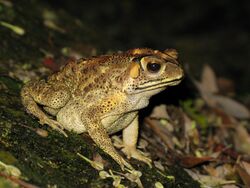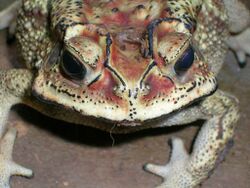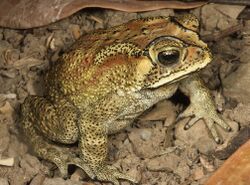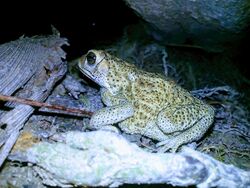Biology:Duttaphrynus melanostictus
| Duttaphrynus melanostictus | |
|---|---|

| |
| Scientific classification | |
| Domain: | Eukaryota |
| Kingdom: | Animalia |
| Phylum: | Chordata |
| Class: | Amphibia |
| Order: | Anura |
| Family: | Bufonidae |
| Genus: | Duttaphrynus |
| Species: | D. melanostictus
|
| Binomial name | |
| Duttaphrynus melanostictus (Schneider, 1799)
| |
| Synonyms | |
|
Bufo melanostictus | |

Duttaphrynus melanostictus is commonly called Asian common toad, Asian black-spined toad, Asian toad, black-spectacled toad, common Sunda toad, and Javanese toad. It is probably a complex of more than one true toad species that is widely distributed in South and Southeast Asia.[1]
The species grows to about 20 cm (8 in) long. Asian common toads breed during the monsoon, and their tadpoles are black. Young toads may be seen in large numbers after monsoon rains finish.
Characteristics
The top of the head has several bony ridges, along the edge of the snout (canthal ridge), in front of the eye (preorbital), above the eye (supraorbital), behind the eye (postorbital), and a short one between the eye and ear (orbitotympanic). The snout is short and blunt, and the space between the eyes is broader than the upper eyelid width. The ear drum or tympanum is very distinct and is at least as wide as two-thirds the diameter of the eye. The first finger is often longer than the second and the toes are at least half webbed. A warty tubercle is found just before the junction of the thigh and shank (subarticular tubercle) and two moderate ones are on the shank (metatarsus). No skin fold occurs along the tarsus. The “knee” (tarsometatarsal articulation) reaches the tympanum or the eye when the hind leg is held parallel along the side of the body. The dorsal side is covered with spiny warts. The parotoids are prominent, kidney-shaped, or elliptical and elongated, and secrete milky white Bufotoxin. The dorsal side is yellowish or brownish and the spines and ridges are black. The underside is unmarked or spotted. Males have a subgular vocal sac and black pads on the inner fingers that help in holding the female during copulation.[2]
Ecology and behaviour
File:Duttaphrynus melanostictus, mating.webm
Asian common toads breed in still and slow-flowing rivers and temporary and permanent ponds and pools. Adults are terrestrial and may be found under ground cover such as rocks, leaf litter, and logs, and are also associated with human habitations. The larvae are found in still and slow-moving waterbodies.[1] They are often seen at night under street lamps, especially when winged termites swarm. They have been noted to feed on a wide range of invertebrates, including scorpions.[3] Tadpoles grown in sibling groups metamorphosed faster than those that were kept in mixed groups.[4] Tadpoles have been shown to be able to recognize kin.[5] The 96h LC50 of commercial grade malathion for the tadpoles is 7.5 mg/L and sublethal levels of exposure can impair swimming.[6]
Distribution and habitat
Asian common toads occur widely from northern Pakistan through Nepal, Bangladesh, India including the Andaman and Nicobar Islands, Sri Lanka, Myanmar, Thailand, Laos, Vietnam, Cambodia, southern China , Taiwan, Hong Kong and Macau to Malaysia, Singapore, and the Indonesian islands of Sumatra, Java, Borneo, Anambas and Natuna Islands. They have been recorded from sea level up to 1,800 m (5,900 ft) altitude, and live mostly in disturbed lowland habitats, from upper beaches and riverbanks to human-dominated agricultural and urban areas. They are uncommon in closed forests.[1]
Introductions
Madagascar
D. melanostictus arrived in Madagascar in 2011 at the port of Toamasina, and by 2014, was found in a 100 km2 (39 sq mi) zone around that city.[7]
Since its discovery on the east coast, a grave fear has developed that if the Asian toad is not eradicated from Madagascar and stronger quarantines are not developed to prevent reinvasion, it could have comparable impacts to those of cane toads in Australia.[8] Because – like Australia's – Madagascar's native predators have been isolated from bufonids since the Jurassic, they are thought to lack resistance to toad toxins as found in natural varanid[9] and snake predators of D. melanostictus[10][11] in its native range.
One study analyzed the sequences of the Na+/K+-ATPase gene (sodium-potassium pump) in dozens of Malagasy species that may be feeding on D. melanostictus. It was found that all but one out of 77 species failed to show evidence of resistance to the toad toxin, which strongly suggests that these alien toads can significantly impact the native Malagasy animal life and contribute to the worsening biodiversity crisis in the region.[12][13]
Nevertheless, evidence from one Australian species, the bluetongue lizard, Tiliqua scincoides, produces the possibility that some Malagasy animals do possess resistance to bufotenin because almost identical cardiac glycosides are produced by native plants of the genus Bryophyllum.[14]
Wallacea and West Papua
D. melanostictus was introduced to the Indonesian island of Bali in 1958,[15] Sulawesi in 1974, then subsequently to Ambon, Lombok, Sumba, Sumbawa, Timor and Indonesian New Guinea at Manokwari on the Vogelkop Peninsula. The species is now common at Sentani in far eastern Papua Province.[16][17] The absence of resistance to toad toxins in native snake and varanid predators means that these species could suffer severe declines from the inadvertent spread of the Asian common toad via human traffic,[15] and the currently near threatened New Guinea quoll is also almost certain to be further affected in the lower-altitude portion of its range.[18]
An unwanted species in Australia
The Asian common toad has been detected in Australia at least four times since 2000.[19]
The Asian common toad has been described as one of Australia's “10 most unwanted” species, and “potentially more damaging than the cane toad”.[20] It may cause serious ecological problems due to “competition with native species, its potential to spread exotic parasites and pathogens and its toxicity”.[21] Like cane toads, the Asian common toad secretes toxins from glands in their backs to deter predators. These toxins would beyond reasonable doubt severely affect native predators, such as snakes, goannas[22] and quolls.[18]
The recent rate of incursions suggests a high likelihood of establishment in Australia. So, experts are calling for the Australian government to develop a “high-priority contingency plan” that includes stronger environmental quarantine and surveillance strategies.[23][21]
References
- ↑ 1.0 1.1 1.2 1.3 van Dijk, P. P. (2004). "Duttaphrynus melanostictus". IUCN Red List of Threatened Species 2004. https://www.iucnredlist.org/species/54707/86445591.
- ↑ Boulenger, G. A. (1890). Reptilia and Batrachia. Fauna of British India. London: Taylor and Francis. pp. 505–507. doi:10.5962/bhl.title.5490. https://archive.org/stream/reptiliabatrachi1890boul#page/505/mode/1up.
- ↑ Berry, P. Y.; Bullock, J. A. (1962). "The Food of the Common Malayan Toad, Bufo melanostictus Schneider". Copeia 1962 (4): 736–741. doi:10.2307/1440674.
- ↑ Saidapur, S. K.; Girish, S. (2001). "Growth and Metamorphosis of Bufo melanostictus Tadpoles: Effects of Kinship and Density". Journal of Herpetology 35 (2): 249–254. doi:10.2307/1566115.
- ↑ Saidapur, S. K.; Girish, S. (2000). "The Ontogeny of Kin Recognition in Tadpoles of the Toad Bufo melanostictus (Anura; Bufonidae)". Journal of Biosciences 25 (3): 267–273. doi:10.1007/BF02703935. PMID 11022229.
- ↑ David, M.; Kartheek, R. M. (2015-10-01). "Malathion acute toxicity in tadpoles of Duttaphrynus melanostictus, morphological and behavioural study" (in en). The Journal of Basic & Applied Zoology. Physiology 72: 1–7. doi:10.1016/j.jobaz.2015.01.004. ISSN 2090-9896.
- ↑ R., Arnaud (2014-04-17). "Invasion de crapauds venimeux à Toamasina: une menace pour l'écosystème malgache". Midi Madagasikara. http://www.midi-madagasikara.mg/societe/2014/04/17/invasion-crapauds-venimeux-toamasina-menace-lecosysteme-malgache/.
- ↑ Pearson, Richard G.; ‘Asian common toads in Madagascar: an urgent effort to inform surveys and eradication efforts’; Global Change Biology, 21 (2015), p. 9
- ↑ Ujvaria, Beata; Mun, Hee-chang; Conigrave, Arthur D.; Bray, Alessandra; Osterkamp, Jens; Halling, Petter and Madsen, Thomas ‘Isolation breeds naïvety: island living robs Australian varanid lizards of toad-toxin immunity via four-base-pair mutations’; Evolution, vol. 67 (2013) pp. 289–294
- ↑ Ujvaria, Beata; Casewell, Nicholas R.; Sunagar, Kartik; Arbuckle. Kevin; Wüster, Wolfgang; Log, Nathan; O’Meally, Denis; Beckmann, Christa; King, Glenn F.; Deplazes, Evelyne and Madsena, Thomas; ‘Widespread convergence in toxin resistance by predictable molecular evolution’; Proceedings of the National Academy of Sciences of the United States of America, volume 112, pp. 11911-11916
- ↑ Garcia de Jesus, Erin (October 2, 2020). "This snake rips a hole in living toads' stomachs to feast on their organs". Science News. https://www.sciencenews.org/article/snake-kills-toad-rips-stomach-organs.
- ↑ Marshall, Benjamin Michael; Casewell, Nicholas R.; Vences, Miguel; Glaw, Frank; Andreone, Franco; Rakotoarison, Andolalao; Zancolli, Giulia; Woog, Friederike et al. (June 2018). "Widespread vulnerability of Malagasy predators to the toxins of an introduced toad". Current Biology 28 (11): R654–R655. doi:10.1016/j.cub.2018.04.024. ISSN 0960-9822. PMID 29870701. https://archive.lstmed.ac.uk/8771/1/CurrBio_Toad_MS%20%28003%29.docx.
- ↑ "Toxic toad invasion puts Madagascar's predators at risk, genetic evidence confirms" (in en). ScienceDaily. https://www.sciencedaily.com/releases/2018/06/180604112616.htm.
- ↑ See Price-Rees, Samantha J.; Brown, Gregory P. and Shine, Richard; ‘Interacting Impacts of Invasive Plants and Invasive Toads on Native Lizards’, in The American Naturalist vol. 179, No. 3 (March 2012), pp. 413-422
- ↑ 15.0 15.1 Reilly, Sean B.; Wogan, Guinevere O. U.; Stubbs, Alexander L.; Arida, Evy; Iskandar, Djoko T. and McGuire Jimmy A.; ‘ Toxic toad invasion of Wallacea: A biodiversity hotspot characterized by extraordinary endemism’; Global Change Biology; August 2017, pp. 1-3
- ↑ Frazier, S. (Dec 15, 2011). "Asian Common Toad". Project Noah. http://www.projectnoah.org/spottings/8077245.
- ↑ Frazier, S. (Jun 13, 2011). "Southeast Asian Toad, Asian Common Toad, Spectacled Toad". Project Noah. http://www.projectnoah.org/spottings/6894260.
- ↑ 18.0 18.1 Covacevich, Jeanette, and Archer, Mike; ‘The distribution of the cane toad, Bufo marinus in Australia and its effects on indigenous vertebrates’; Memoirs of the Queensland Museum, volume 17 (1975), pp. 305–310.
- ↑ Henderson W, Bomford M. 2011. Detecting and preventing new incursions of exotic animals in Australia. Invasive Animals Cooperative Research Centre, Canberra.
- ↑ Page A, Kirkpatrick W, Massam M. 2008. Black–spined Toad (Bufo melanostictus) Risk Assessments for Australia; Department of Agriculture and Food: Western Australia. https://pestsmart.org.au/wp-content/uploads/sites/3/2020/06/Bufo_melanostictus_220410.pdf; retrieved 2022-06-03
- ↑ 21.0 21.1 Invasive Species Council, 2014, Biosecurity Failures in Australia, The Asian Black-Spined Toad, https://invasives.org.au/wp-content/uploads/2014/09/Biosecurity-failures-asian-black-spined-toads.pdf; retrieved 2017-05-28
- ↑ Department of Environment and Primary Industries. 2014. Asian black-spined toad. Victorian Government. http://www.depi.vic.gov.au/agriculture-and-food/pests-diseases-and-weeds/pest-animals/a-z-of-pest-animals/asian-black-spine-toad; retrieved 2017-05-28
- ↑ Massam M, Kirkpatrick W and Page A (2010). Assessment and Prioritisation of Risk for Forty Introduced Animal Species. Invasive Animals Cooperative Research Centre, Canberra
Further reading
- Lu, W.; Qing, N. (2010). "Bufo melanostictus (Asian Common Toad). Record size". Herpetological Review 41 (1): 61.
External links
- "Asian toad". Amphibians of Southeast Asia. Ecology Asia. http://www.ecologyasia.com/verts/amphibians/asian_toad.htm.
- "Duttaphrynus melanostictus". Amphibians and Reptiles of Peninsular Malaysia. http://www.amphibia.my/page.php?pageid=s_foundk&s_id=10&search1=Duttaphrynus%20melanostictus&species=Duttaphrynus%20melanostictus&submit=Search!#.
- See also Oligodon fasciolatus for:
- H. Bringsøe et al.: Eviscerated alive: Novel and macabre feeding strategy in Oligodon fasciolatus (Günther, 1864) eating organs of Duttaphrynus melanostictus (Schneider, 1799) in Thailand. In: Herpetozoa. Published online September 11, 2020. doi:10.3897/herpetozoa.33.e57096.
- Erin Garcia de Jesus: This snake rips a hole in living toads’ stomachs to feast on their organs, on: ScienceNews, October 2, 2020
Wikidata ☰ Q28031739 entry
 |





